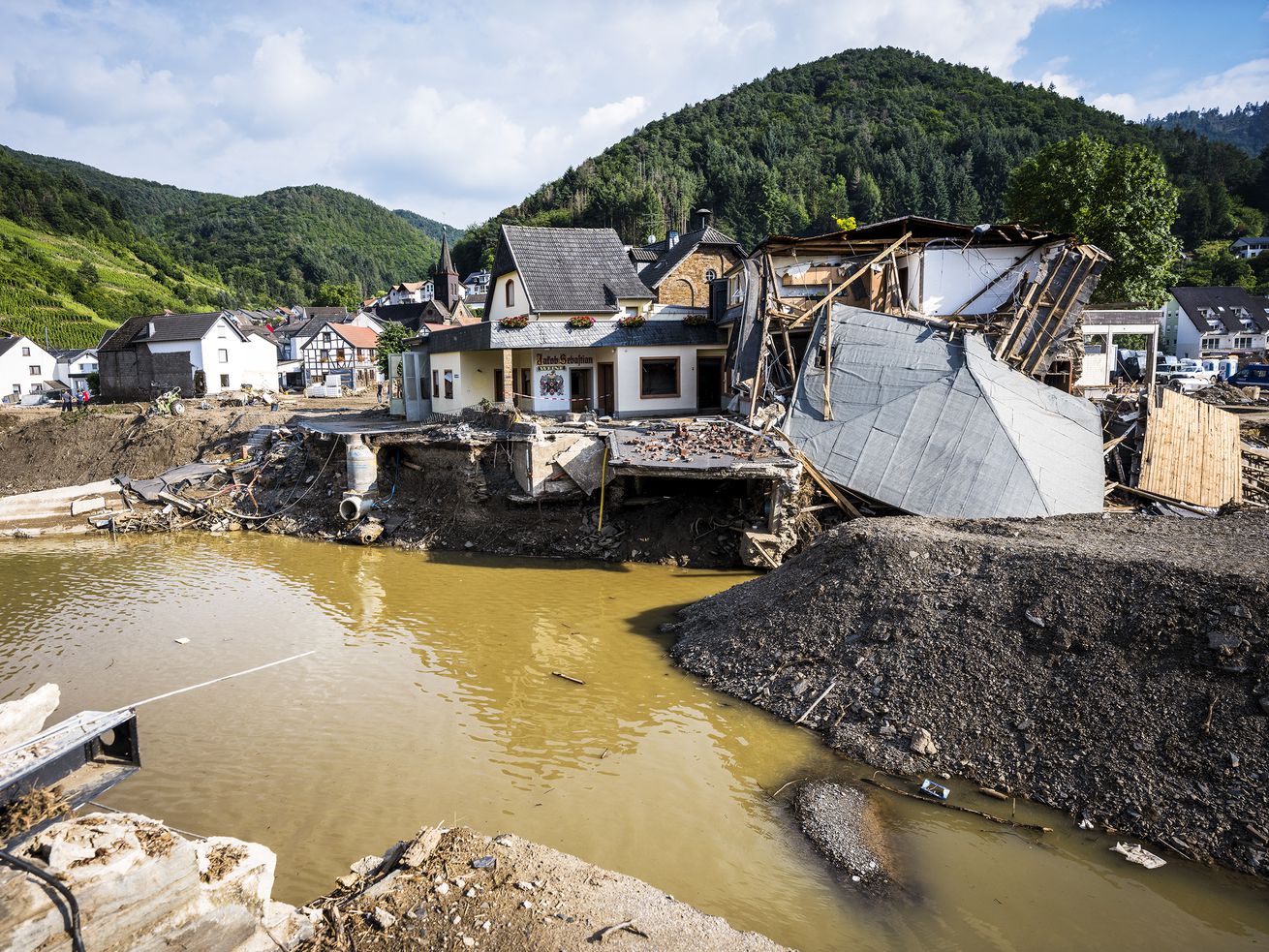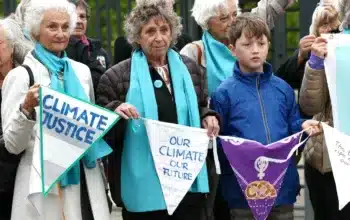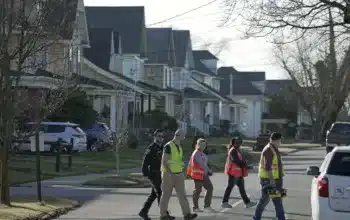“There’s no going back” — and there’s no room for wishful thinking, top climate scientists say.
How much has humanity already changed the climate? And how much worse will it get?
The answers now are sharper than ever, according to an international team of scientists. In a new report, they say that far more aggressive action is needed to limit catastrophic climate change, and that time is running out.
The Intergovernmental Panel on Climate Change (IPCC), the United Nations’ climate science research group, concluded in a major report that it is “unequivocal” that humans have warmed the skies, waters, and lands, and that “widespread and rapid changes” have already occurred in every inhabited region across the globe. Many of these changes are irreversible within our lifetimes.
This is the first report of its kind in eight years, and a lot has changed. Scientists have backed away from many of the best-case scenarios. They’re more confident than ever that human-caused climate change is already worsening deadly weather events, from flooding to heat waves. And they’re investigating culprits of climate change that warm the planet even more than carbon dioxide.
The report warns that the world is likely to overshoot 1.5 degrees Celsius of warming compared to pre-industrial temperatures — one of the goalposts of the Paris climate agreement — within the next 20 or 30 years, even under scenarios where greenhouse gas emissions fall significantly. It’s a stark warning for the 195 countries meeting later this year in Glasgow, Scotland, to come up with more ambitious goals for fighting climate change — although many of those countries are not on track to meet even their previous targets.
“This report tells us that recent changes in the climate are widespread, rapid, and intensifying, unprecedented in thousands of years,” Ko Barrett, vice chair of the IPCC and senior adviser for climate at the National Oceanic and Atmospheric Administration, said in a press conference. Climate change “is already affecting every region on earth in multiple ways,” Barrett said. “There’s no going back from some changes in the climate system.”
Those effects of climate change continue to ripple across the planet, amplifying disasters like the massive wildfires in California, deadly flooding in China and Europe, and record heat in Siberia. Climate change is here, and unless drastic action is taken, it will only get worse.
This first installment of the latest report, known as the Sixth Assessment Report (AR6), goes over the physical sciences of climate change, examining what’s fueling planetary warming in the atmosphere, oceans, and on land. It covers the body of research that’s emerged over the eight years since the previous report. Subsequent chapters due out over the coming months will look at economic and environmental vulnerabilities to climate change, as well as the options for mitigating warming.
The goal of these reports is to compile the best available science and create a solid foundation for decision-makers to act, whether that’s to invest in clean energy, relocate people from high-risk areas, or help the most vulnerable places cope with unavoidable impacts. IPCC reports are considered to be the definitive assessments of the science behind climate change. Past IPCC reports have been cited in coastal construction plans, drought risk estimates, and even lawsuits.
While researchers have better answers now on some fronts, they are also blunt about the things they still don’t know, which could have huge effects on the livability of the planet. Certain tipping points, feedbacks, and currently unappreciated mechanisms could further tilt the climate out of balance in ways that are hard to predict.
/cdn.vox-cdn.com/uploads/chorus_asset/file/22766794/GettyImages_1234219943.jpg) Josh Edelson/AFP/Getty Images
Josh Edelson/AFP/Getty ImagesClimate science has advanced rapidly, but climate action has not
With the AR6 report, the IPCC is building on assessments in recent years that tackled specific issues, such as the shrinking window in which the world could keep future warming below 1.5 degrees Celsius. The IPCC also studied climate change impacts on oceans and frozen regions and the strain on the world’s food and water supplies from rising temperatures.
These reports helped ignite a global movement, most notably among young people, demanding that world leaders do more to uphold their commitments under the Paris agreement before time runs out.
But in the eight years since the last comprehensive IPCC report and the six years since the Paris accords, humanity’s output of heat-trapping gases has only grown. Even with a dip in emissions stemming from the Covid-19 pandemic, carbon dioxide concentrations in the atmosphere reached a record high this year, topping 419 parts per million, a level the planet has not seen for at least 2 million years.
This rise in emissions has given scientists unprecedented opportunities to study climate change in real time. Alongside improvements in computer simulations, measurement technology, laboratory experiments, and historical records, scientists have gained far more insight to, and confidence in, humanity’s role in cranking up the planet’s thermostat.
In general, IPCC reports don’t contain much in the way of new revelations, since they are compiled from existing research: AR6 is based on research published before January 31, 2021, and draws on 14,000 research articles. But paper by paper, these reports illustrate how confident scientists are in the mechanisms behind climate change and show how their understanding has changed.
Here are some of the most notable sections of the new report:
Scientists are even more confident that climate change worsens extreme weather
“What’s new in this report is that we can now attribute many more changes at the global and regional level to human influence and better project future changes we will see from different amounts of emissions,” said Barrett.
The world has already warmed 1.1 degrees Celsius since the dawn of the industrial revolution. It’s clear that humanity’s gargantuan output of greenhouse gases — currently about 2.6 million pounds of carbon dioxide per second — is the culprit. Without the combustion of fossil fuels, the planet would very likely be much cooler.
/cdn.vox-cdn.com/uploads/chorus_asset/file/22770222/Screen_Shot_2021_08_08_at_7.33.51_PM.png) IPCC
IPCCThis deceptively small shift in average temperatures increases the likelihood and severity of extreme events and is already worsening disasters around the world. Now scientists can tease out just how much human emissions of greenhouse gases is making them worse.
This is due to advances in an area of climate science called attribution that have led to a better understanding of the climate before industrialization, as well as models of a hypothetical world without human intervention. “Evidence of observed changes in extremes such as heatwaves, heavy precipitation, droughts, and tropical cyclones, and, in particular, their attribution to human influence, has strengthened since [the previous IPCC report],” according to the report.
With these methods, scientists can establish just how much burning fossil fuels has increased the likelihood of extreme events like heat waves. The report says it’s “virtually certain” that extreme heat events have increased in frequency and intensity because of humans. Researchers can also measure how much worse coastal flooding has become due to rising sea levels stemming from warming.
Climate change is global, but the effects are local
With improved measurements and modeling, scientists have been able to zoom in on parts of the planet and gain a better sense of how climate change will play out. While the world is warming on average, specific locations have been hit with especially stark changes. AR6 includes an interactive atlas showing some of these effects around the world.
For instance, some warming regions are projected to dry out, while others are poised to get wetter. In some instances, both can happen in the same place — the averages may not shift much, but the extremes may grow, leading to periods of drought followed by deluge. This weather whiplash wasn’t appreciated as much until recently and is yet another signal of how humans are changing the climate.
“This whiplash — this increase in both the extreme wet and dry events — are projected to increase over the 21st century,” said Kim Cobb, lead author of the first chapter of AR6 and director of the Global Change Program at Georgia Tech, during a press conference.
And as temperatures continue to rise, these extremes “will worsen within each increment of additional warming,” said Cobb. However, with more specific and local information about the impacts of climate change, IPCC authors hope that the report will be more useful for making decisions about planning for and mitigating warming.
Carbon dioxide is not the only villain
Scientists have long understood that carbon dioxide — the gas that spews from chimneys, tailpipes, and smokestacks — plays the biggest role in global warming and will continue to influence the climate for hundreds of years. But the report says that other greenhouse gases are a growing cause for concern.
Methane in particular can trap even more heat than carbon in the near term, over the span of 20 years, and countries that have focused on carbon emissions may be less prepared to control it. Scientists know methane pollution is at its highest level in 800,000 years because of human activities like agriculture and oil and gas production, and that other greenhouse gases like nitrogen dioxide are also rising.
The upside is that because these gases are so potent at trapping heat, reducing their emissions has outsized benefits for mitigating climate change.
There’s no more room for wishful thinking
There are two broad variables that shape climate forecasts: what humans will do, and what the planet will do in response.
As scientists resolve the physics of climate change, they can better project how the planet will respond to a given concentration of greenhouse gases. This response is known as equilibrium climate sensitivity, which estimates what would happen if carbon dioxide concentrations in the atmosphere doubled compared to pre-industrial levels, reaching around 560 ppm.
This year’s AR6 report found that a doubling of CO2 concentrations would warm the planet by about 3°C, with a likely range between 2.5°C and 4°C. The last big IPCC report, in 2013, gave a range of 1.5 to 4.5°C of warming.
As for humanity’s actions, the IPCC has established five scenarios for human greenhouse gas emissions, known as shared socioeconomic pathways (SSPs). Even in the best-case scenario for reducing greenhouse gas emissions, IPCC authors expect that warming will continue until at least the middle of the century. Among the five scenarios, scientists expect the world to surpass the Paris agreement’s 1.5°C warming target in all of them, but in the “very low emissions” SSP, the planet’s temperature is expected to eventually fall below this threshold before the end of the century.
/cdn.vox-cdn.com/uploads/chorus_asset/file/22770899/SSP_Chart.png) IPCC
IPCCSome of the most dire forecasts of warming appear to be less likely in this recent report, but so do many of the more favorable outcomes. According to the report, it now seems impossible that the world will get lucky and warming will somehow stay within the Paris agreement targets without massive action to limit emissions, starting right away.
The new IPCC report raises several new mysteries of climate change
We know humans are dangerously warming the planet through human activities like burning fossil fuels and clearing lands for agriculture and urban development. The models have gotten more accurate in recent years, but there are still unanswered questions.
Where is all that methane coming from?
Methane is rising, but exactly what are the causes? Scientists generally know that methane comes from a mix of natural sources, like wetlands and melting permafrost, and human sources, like oil and gas, agriculture, and landfills. The report doesn’t name which of the human sources are the biggest culprit, and it doesn’t look very closely at feedback loops, which in a warming world will generate even more of this damaging gas. And the world still doesn’t monitor the oil and gas industry closely enough to identify and plug the leakiest oil and gas facilities.
Will clouds help heat up the planet or cool it off?
One of the largest sources of uncertainty in climate models is clouds, as Vox’s podcast Unexplainable has explored. These puffs of moisture in the atmosphere are complicated, difficult to predict, and can have wildly different impacts depending on specific conditions in a given spot in the sky. Clouds change the distribution of rainfall over the planet, but they can influence temperatures too. Low-altitude clouds tend to bounce sunlight back into space and have a net cooling effect, while clouds at high altitudes trap heat by absorbing and re-emitting infrared radiation. Exactly which clouds form and where they occur as temperatures rise will have huge implications for how climate change plays out on the ground.
Are there any tipping points?
One of the most worrisome potential consequences of climate science is crossing tipping points at which humans trigger irreversible, catastrophic impacts that accelerate the global changes. The report considers these events to have a low likelihood of happening this century, but they are frightening to consider.
For example, thawing permafrost could release huge quantities of carbon dioxide and methane, which further enhance warming without human intervention. Warming could also reach a point where critical ocean circulation patterns stall, leading to global changes in rainfall and sea levels. Changes in the climate could also cause critical ecosystems like tropical rainforests to enter a cycle of collapse.
If one of these potential thresholds is breached, then the damaging effects of warming will continue even if every country drastically curbs greenhouse gas emissions.
What will humans actually end up doing?
The biggest unanswered question about the future remains the same: What will humanity do to mitigate climate change? “The main issues are what are the people on our planet going to choose as future directions for energy, transportation, and land use, the primary drivers of the changing climate,” said Donald Wuebbles, a professor of atmospheric science at the University of Illinois and an author of the previous IPCC report, in an email.
/cdn.vox-cdn.com/uploads/chorus_asset/file/22766793/GettyImages_1233974389.jpg) David Paul Morris/Bloomberg/Getty Images
David Paul Morris/Bloomberg/Getty ImagesIt all comes down to what people do with this information
The IPCC’s process for generating these reports is tedious, requiring every word to be approved by representatives from 195 countries. AR6 generated more than 70,000 comments. So the framing of the results tends to be limited by the consensus.
That the group has reached such stark conclusions shows that humanity has already done significant damage to the climate, and even more dire consequences are ahead without drastic, worldwide action. IPCC authors insist that this report is not meant to prescribe specific tactics or targets for dealing with climate change, but given the projections of disaster and dislocation, anyone who reads the report will be hard-pressed to come away with anything other than a sense of urgency.
“It does provide a very compelling case for more aggressive actions,” Jane Lubchenco, the White House’s deputy director of the Office of Science and Technology Policy, said in an interview.
For leaders, the report could serve as an important justification for doing more to mitigate climate change. The next big test of this will be at the November 26 Conference of Parties (COP26) meeting, where the signatories to the Paris agreement are expected to raise their ambitions for mitigating climate change.
“The IPCC report underscores the overwhelming urgency of this moment,” said John Kerry, the US special envoy for climate, in a statement. “We can get to the low carbon economy we urgently need, but time is not on our side. This is the critical decade for action, and COP26 in Glasgow must be a turning point in this crisis.”
For climate activists, this report is a stark reminder that the world is doing nowhere near enough to meet its current climate goals — let alone stepping up to actually keep warming in check.
The upcoming chapters of AR6 will go into more practical questions of what tactics will actually be meaningful for limiting warming, but this first chapter focusing on the science leaves no room for wishful thinking. Avoiding the worst consequences of climate change demands far more drastic and urgent action to cut greenhouse gas emissions right away, according to Maisa Rojas Corradi, an IPCC author and director of the Center for Climate and Resilience Research at the University of Chile.
“Is it still possible to limit global warming to 1.5 degrees? The answer is yes, but unless there are immediate, rapid and large-scale reductions of all greenhouse gases, limiting global warming to 1.5 degrees will be beyond reach,” she said.
Author: Umair Irfan
Read More



